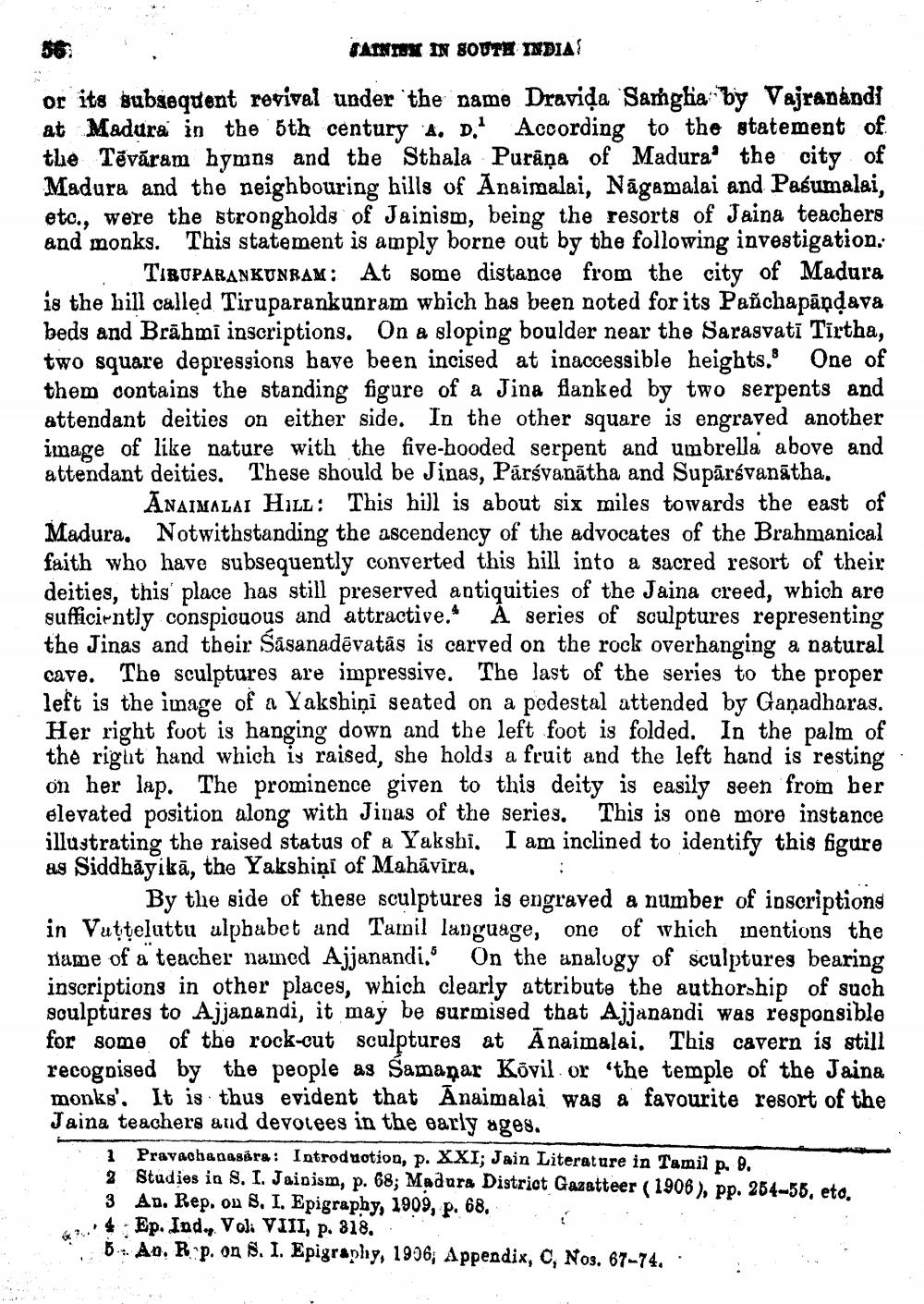________________
TATNINN IN SOUTH INDIA
or its subsequent revival under the name Dravida Samghia by Vajranandi at Madura in the 5th century A. D. According to the statement of the Tēvāram hymns and the Sthala Purāņa of Madura® the city of Madura and the neighbouring hills of Anaimalai, Nāgamalai and Pasumalai, etc., were the strongholds of Jainism, being the resorts of Jaina teachers and monks. This statement is amply borne out by the following investigation.
TIBUPARANKUNRAM: At some distance from the city of Madura is the hill called Tiruparankunram wbich has been noted for its Pañchapāņdava beds and Brāhmi inscriptions. On a sloping boulder near the Sarasvati Tirtha, two square depressions have been incised at inaccessible heights. One of them contains the standing figure of a Jina flanked by two serpents and attendant deities on either side. In the other square is engraved another image of like nature with the five-hooded serpent and umbrella above and attendant deities. These should be Jinas, Pārsvanātha and Supārsvanātha.
ĀNAIMALAI Hill: This hill is about six miles towards the east of Madura. Notwithstanding the ascendency of the advocates of the Brahmanical faith who have subsequently converted this hill into a sacred resort of their deities, this place has still preserved antiquities of the Jaina creed, which are sufficiently conspicuous and attractive. A series of sculptures representing the Jinas and their Śásanadēvatās is carved on the rock overhanging a natural cave. The sculptures are impressive. The last of the series to the proper left is the image of a Yakshiņi seated on a pedestal attended by Ganadharas. Her right foot is hanging down and the left foot is folded. In the palm of the right hand which is raised, she holds a fruit and the left hand is resting on her lap. The prominence given to this deity is easily seen from her elevated position along with Jinas of the series. This is one more instance illustrating the raised status of a Yakshi. I am inclined to identify this figure As Siddhāyikā, the Yakshiņi of Mahāvīra, :
By the side of these sculptures is engraved a number of inscriptions in Vutteluttu alphabet and Tamil language, one of which inentions the name of a teacher named Ajjanandi. On the analogy of sculptures bearing inscriptions in other places, which clearly attribute the authorship of such soulp
res to Ajjanandi, it may be surmised that Ajjanandi was responsible for some of the rock-cut sculptures at Ānaimalai. This cavern is still recognised by the people as Samanar Kõvil or 'the temple of the Jaina monks'. It is thus evident that Anaimalai was a favourite resort of the Jaina teachers and devotees in the early ages.
i Pravachanasara : Introduotion, p. XXI; Jain Literature in Tamil p. 0. 2 Studies in 8. I. Jainism, p. 68; Madura District Gazetteer (1906), pp. 254-58, eto, 3 An. Rep. on S, I. Epigraphy, 1909, p. 68. 4Ep. Ind. Voli VIII, p. 318... 3. A0. Rip. on S. I. Epigraphy, 1996; Appendix, C, Nos. 67-74..




